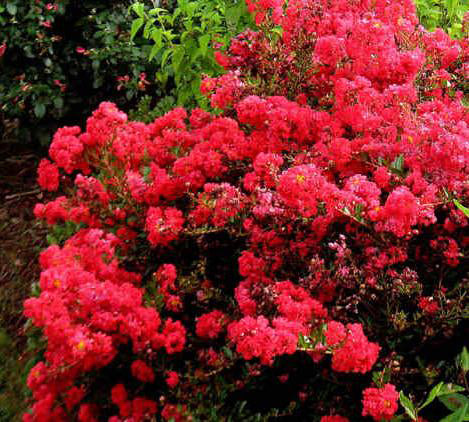 Finally! The monsoons have arrived over most of the state. Before cheering when you hear “50% chance of rain”, you need to remember what that forecast really means in the mountains of Arizona: The weatherman is telling you that half the neighborhood could see rain. It’s very possible that your neighbor’s yard could get rain and your garden is left high-and-dry. You never know where that precious line of demarcation to nature’s hydration will fall.
Finally! The monsoons have arrived over most of the state. Before cheering when you hear “50% chance of rain”, you need to remember what that forecast really means in the mountains of Arizona: The weatherman is telling you that half the neighborhood could see rain. It’s very possible that your neighbor’s yard could get rain and your garden is left high-and-dry. You never know where that precious line of demarcation to nature’s hydration will fall.
Even if we don’t see actual droplets the humidity is up, so plants are celebrating. However, the monsoon season, now through the end of September, can be a challenging time in the garden unless you take a few easy steps to prevent unwanted issues.
For best hydration, water landscapes only in the early dawn hours, preferably before 8:00 a.m. This will ensure that plants are prepared for the heat of day without increasing their risk of powdery mildew. This is important! Powdery mildew is a nasty white powder that thrives in our monsoon conditions and incorrect irrigation only exacerbates its effects. Do what you can to keep the landscape dry through the evening hours; foliage that stays cool and wet encourages this disease. Keep a sharp eye out for this malady, a white powder that seems to devour the foliage of plants, stops blooming, and what foliage does remain is small and emaciated.
Grasshoppers just hatched, so now is the time to crush these chewing monsters. Organic NOLO Bait hurts no other insect, bird, or animal, just grasshoppers, but timing is everything. Use it NOW!! Spread this wheat-laced product along the perimeter of your landscape in the weeds where grasshoppers are feeding.
I also recommend placing a birdbath in the yard to encourage birds to hang out in your yard and garden. Grasshoppers have few predators to fear, but our feathered garden friends are to grasshoppers what the dragons of old were to knights so bold.
Along with a bumper crop of Thai peppers, I’ve picked the first ripe tomato from my garden. The mouth-watering garden season has begun! If you are having trouble with tomato vines not setting fruit, try this technique that I use religiously. Each week I spray my vines alternately with “Blossom Set Spray” and “Rot-Stop”.
First, I spray the entire plant with Blossom Set Spray. One week later I spray the entire plant with Rot-Stop. I practice this regimen throughout the season. My plants set more fruit and have a richer green hue. This program works equally well on peppers, eggplants, cucumbers, and melons. Available in a practical quart size, these two products force vegetable plants to set fruit without spotting.
~~ ~~ ~~ ~~ ~~ ~~ ~~
Enough about routine garden tasks, let’s get the to the fun stuff in the landscape, the stuff that excites even the most seasoned gardeners. I’m referring to the amazing number of plant introductions in stunning new colors that arrived at garden centers this week.
Brake Lights Hesperaloe – This Arizona native has vibrant, brake-light-red flowers that hover above classic blue sword foliage. I guarantee you’ve never seen red like this coming from a yucca. It’s a striking contrast to the standard form, which tends to be more pink or salmon in color. This compact grower grows to two feet tall and enjoys an extremely long bloom season. Wonderful in containers or massed into groups, it delivers a dramatic statement to any landscape.
Razzle Dazzle Crepe Myrtle – This exciting new plant was developed with the desirable attributes of easy care and mildew resistance. With a mature height of 4 feet and winter hardiness to -10 degrees, it’s the perfect perennial for a mountain landscape. Few shrubs have such intense razzle-dazzle flower power through the heat of summer.
Balboa Sunset Trumpet Creeper – is the plant in this week’s photo. Clusters of 3-4” dark red flowers are so stunning they’re like candy to gardeners. This lighting-fast growing vine can quickly cloak shade arbors. Snake it up posts or columns to overhead trellises at entries and gateways. Allowed to sprawl up bare hillsides, walls, and rooftops, and cascade down retaining walls it will bloom in summer’s heat. It’s one of the best vines for masking old unattractive fences and outbuildings, and to hold open soil in place during the heaviest monsoon rains. Hummingbirds find the fragrance irresistible and so will you.
~~ ~~ ~~ ~~ ~~ ~~ ~~
Take a gardening class! Every Saturday morning @ 9:30 I host a gardening class. Today’s is entitled ‘Better Fruits, Grapes & Berries’; the July 16 class is ‘Landscape 4 Less Care & Water ‘. Bring your garden hat, a mug of coffee, and hang out with other really cool locals who enjoy gardening.
‘The Mountain Gardener’, my radio show uniquely about mountain gardening, is broadcast every Saturday throughout the mountains of Arizona. The show airs from 10:00 to11:00 am on the K-Jazz radio network at 90.1 Prescott, 89.5 Williams, 90.7 Kingman, and in Flagstaff on the 89.5 and 91.3 FM radio frequencies. The same garden show is also broadcast on KQNA, Northern AZ’s News and Sports station, every Saturday from 11:00 to noon on 99.9 FM and 1130 AM. The program is entertaining, informative, and most importantly, it’s all about local landscapes.
Until next week, I’ll see you in the garden center.

